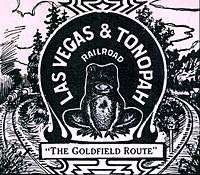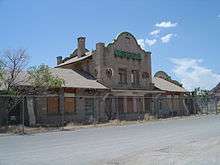Las Vegas and Tonopah Railroad
 | |
| Locale | Las Vegas - Goldfield, Nevada |
|---|---|
| Dates of operation | 1906–1918 |
| Track gauge | 4 ft 8 1⁄2 in (1,435 mm) standard gauge |
| Headquarters | Los Angeles, California |
The Las Vegas and Tonopah Railroad was a 197.9 mile railroad built by William A. Clark that ran northwest from a connection with the mainline of the San Pedro, Los Angeles and Salt Lake Railroad at Las Vegas, Nevada to the gold mines at Goldfield. The SPLA&SL railroad later became part of the Union Pacific Railroad and serves as their mainline between Los Angeles and Salt Lake City.
History
In April 1905, Clark made a verbal agreement with Francis Marion Smith that Smith could build a rail line to his borax operations at Lila C connecting with the San Pedro, Los Angeles and Salt Lake Railroad at Las Vegas. After Smith's men had already graded 12 miles for tracks, his workers received a no trespassing order that they were not allowed to connect with Clark's rail. Clark had apparently changed his mind, and subsequently, he laid his own rail on the line graded by Smith's men. In response, Smith started his own competing railroad, the Tonopah and Tidewater to the Goldfield boomtowns in direct competition with Clark.[1]

The Las Vegas and Tonopah Railroad was incorporated on September 22, 1905. On March 1, 1906, the track was completed between Las Vegas and Indian Springs. By June 30, 1906, the line was over 50% completed (100 miles or 160 kilometres), reaching Rose's Well. In December 1906 the tracks reached Rhyolite. Finally, in November 1907 the entire 198-mile (319 km) line was in operation between Las Vegas and Goldfield.
The northern end of the line (Beatty - Goldfield) was only in operation from 1908 - 1914. That 80 miles (130 km) of track was removed during World War I. The Las Vegas & Tonopah continued to serve the Bullfrog Mining District at Beatty until 1917/1918. By 1919, the remaining 110 miles (180 km) of track was abandoned and scrapped.
Operations

In 1906 the 118-mile (190 km) trip from Las Vegas to Beatty took 6 hours. Trains operated daily until February 1, 1917, and then became tri-weekly until abandonment.
The railroad had three passenger cars. One of them, a Harriman type chair car #30, was built in 1907 by the Pullman Company, is awaiting restoration at the Nevada State Railroad Museum.[2]
The LV&T depot at Rhyolite still remains. It was constructed in 1909 at a cost of $130,000.[3]
Locomotives
The railroad primarily used "Ten Wheeler" 4-6-0 and Consolidation (2-8-0) type locomotives, primarily manufactured by Brooks and Baldwin Locomotive Works. The railroad's first four locomotives were purchased in used condition. The railroad would later purchase 12 additional new locomotives. Upon abandonment of the railroad in 1917/1918, these locomotives were sold to the Northwestern Pacific Railroad, the Los Angeles and Salt Lake Railroad and the San Diego and Arizona Railway.
Preservation
All that is known to still exist of the once extensive rolling stock of the LV&T, one coach has been preserved by the Nevada Northern Railway Museum but it has not yet been refurbished and still awaits restoration to this very day.
Route
- Las Vegas MP 0.0
- Tule
- Corn Creek
- Owens
- Indian Springs MP 43.0
- Charleston, possibly named after nearby Mount Charleston, 4th highest peak in Nevada
- Amargosa MP 74.0
- Canon
- Rosewell (Rose's Well) MP 100.0
- Chloride
- Beatty MP 118.4
- Rhyolite MP 123.4 with Branch to Montgomery-Shoshone Mine
- Original
- Mud Springs
- Midway
- Bonnie Claire
- Wagner
- Stonewall
- Ralston, possibly named after Ralston Valley
- Red Rock
- Milltown
- Columbia
- Goldfield MP 196.9
See also
References
- ↑ "The Great Desert Railroad Race" Documentary written and produced by Ted Faye
- ↑ "Las Vegas & Tonopah Chair Car No. 30 - "Tonopah"". Nevada State Railroad Museum. December 25, 2003. Retrieved September 17, 2008.
- ↑ "The Las Vegas & Tonopah Railroad Depot". Rhyolite Ghost Town, Nevada. Retrieved 2008-09-17.
- Myrick, David F. (1962). Railroads of Nevada and Eastern California, Volume One - The Northern Roads. Berkeley, California: Howell-North Books. ISBN 0-87417-193-8.
- Robertson, Donald B. (1986). Encyclopedia of Western Railroad History - The Desert States. Caldwell, ID: The Caxton Printers. ISBN 0-87004-305-6.
- Walker, Mike (1997). Steam Powered Video's Comprehensive Railroad Atlas of North America - California and Nevada - Post Merger Ed. Kent, United Kingdom: Steam Powered Publishing. ISBN 1-874745-08-0.
External links
| Wikimedia Commons has media related to Las Vegas and Tonopah Railroad. |